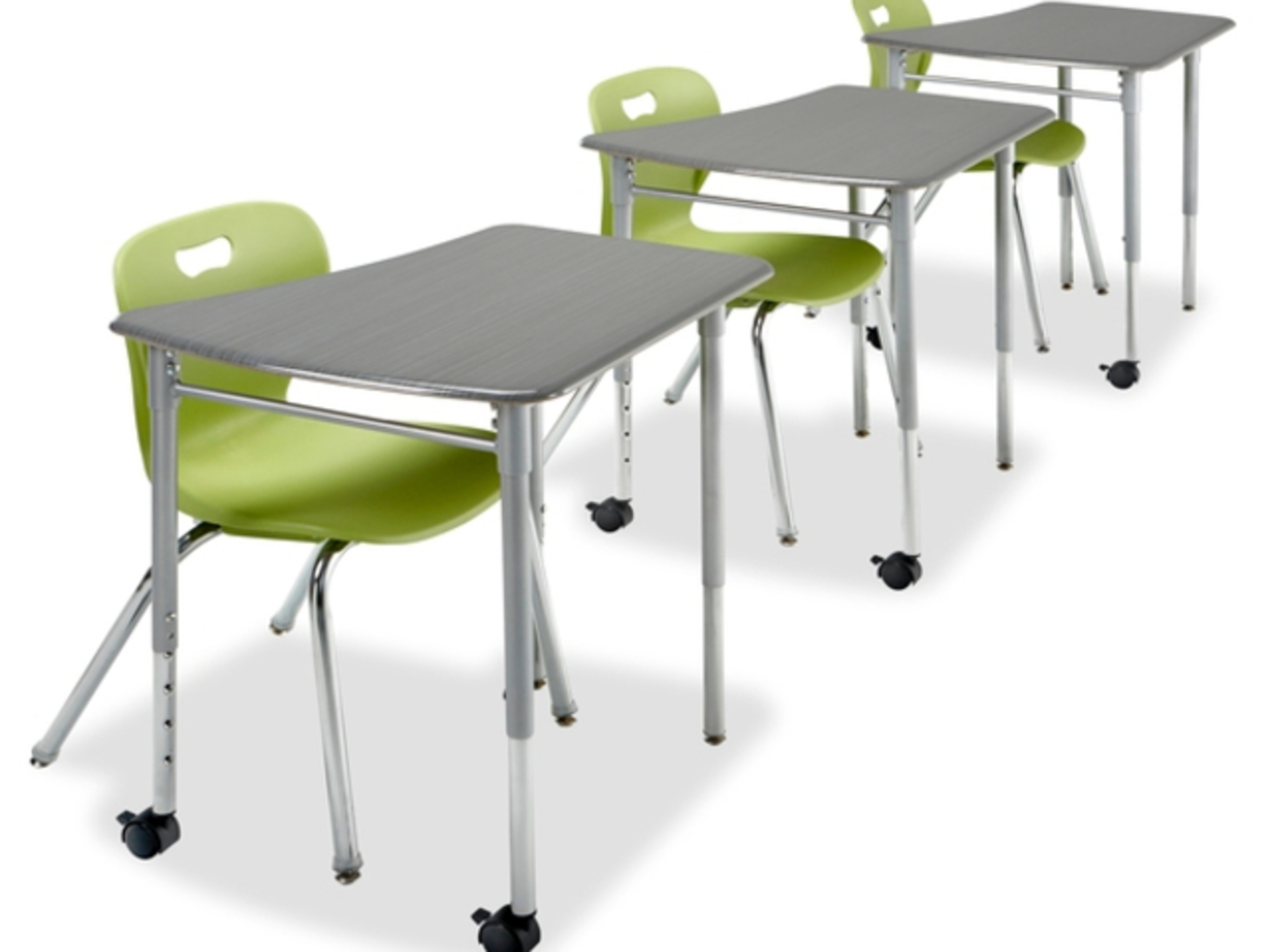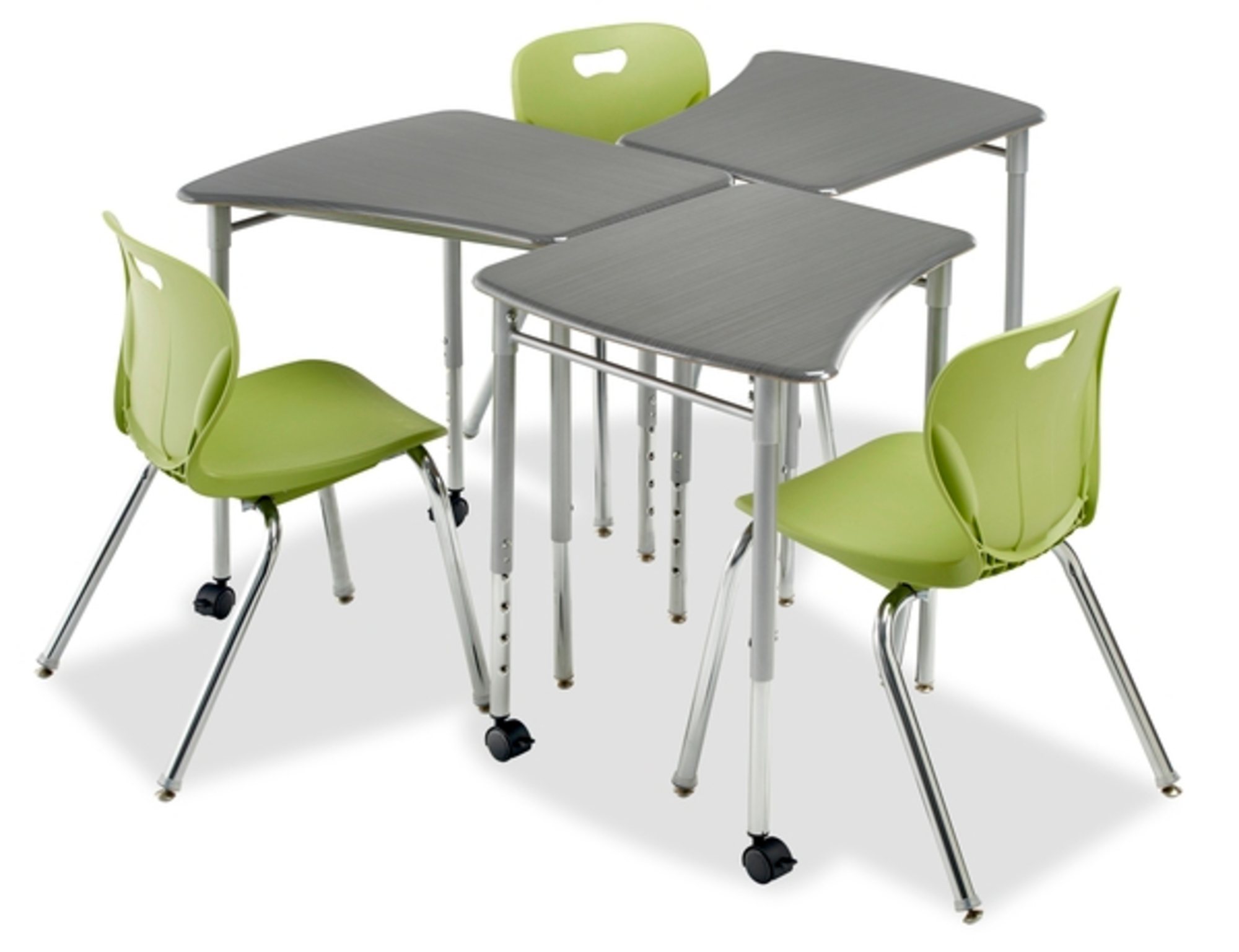
23 Oct The Benefits of Adjustable Flow Desks for Active Learning
When it comes to classroom interior design, one of the hottest trends is the shift toward creating more flexible, dynamic learning environments. And right at the heart of that movement are adjustable flow desks. These innovative desks do more than just serve as a spot for students to work—they open up new possibilities for how students interact, move, and learn.
If you’ve ever sat through hours of classes or meetings in a traditional, stiff chair, you know how hard it can be to stay focused. Now imagine you’re a student with boundless energy. Sitting still for long stretches can be a real challenge. This is where flow desks come in, offering students the ability to sit, stand, or even move while they work. They allow for freedom of movement and a more active approach to learning.
What Are Adjustable Flow Desks?
For those who might not be familiar with the term, adjustable flow desks (also known as sit-stand desks or flexible desks) are workstations that can be adjusted in height. Students can easily change the desk’s position, transitioning from sitting to standing, often with just a quick lever adjustment. Some flow desks are designed with wheels, so they can move around the classroom to accommodate different activities.
In the context of classroom interior design, flow desks are a game-changer because they allow educators to create flexible, dynamic spaces that adapt to different learning styles and teaching methods. But the benefits go far beyond just being able to move desks around.
Let’s dive into some of the key advantages of using adjustable flow desks in active learning environments.
1. Improved Focus and Engagement
One of the biggest benefits of adjustable flow desks is how they help improve focus and engagement among students. Sitting for long periods can lead to restlessness, fatigue, and ultimately, a wandering mind. Flow desks encourage movement, which increases blood flow and keeps students more alert. When students have the option to switch between sitting and standing, they can better manage their energy levels throughout the day.
Studies have shown that students who use sit-stand desks often report feeling more focused and less tired than those who remain seated. This is especially true for younger students who might struggle to stay still in traditional classroom settings. The ability to stand up when they need to can help them channel that extra energy into more productive activities rather than fidgeting or getting distracted.

2. Encouraging Better Posture and Health
Classroom interior design is often about finding the balance between aesthetics and functionality. With adjustable flow desks, you get both. Beyond the obvious benefit of keeping students engaged, these desks promote better posture and overall physical health.
Think about how much time students spend seated—up to six or seven hours a day, five days a week. Poor posture over extended periods can lead to long-term issues like back pain, neck strain, and even reduced lung capacity. Flow desks help combat these problems by encouraging movement and allowing students to maintain better posture.
When students have the option to stand and stretch throughout the day, it reduces the risk of developing physical discomfort that can distract them from learning. And, as an added bonus, fostering good posture habits at a young age can lead to better health outcomes later in life.

3. Promoting Active Learning
Active learning is a method that emphasizes student participation and engagement with the material. It encourages students to get involved in discussions, problem-solving, and collaborative activities, rather than passively receiving information. Adjustable flow desks are perfectly suited for this kind of learning environment.
With the flexibility to quickly change positions and move around the classroom, flow desks make it easier to organize group activities or rearrange seating for different tasks. Need to break the class into small groups? Flow desks can be effortlessly moved to create new configurations. Want to set up stations for hands-on activities? Flow desks can be adjusted and positioned to suit various needs.
By incorporating flow desks into classroom interior design, teachers can create a space that adapts to the lesson plan rather than forcing the lesson to fit the space. This fluidity helps keep students engaged and makes it easier to integrate a variety of learning styles.
4. Encouraging Collaboration
Speaking of collaboration, adjustable flow desks make it much easier for students to work together. In traditional classroom settings, desks are often bolted down or arranged in fixed rows, making group work challenging. Flow desks, on the other hand, can be moved and grouped as needed, fostering more interaction between students.
This flexibility encourages peer-to-peer learning, where students can share ideas, help each other solve problems, and collaborate on projects. In a classroom designed with flow desks, collaboration isn’t an afterthought—it’s built into the very design of the space.

5. Meeting the Needs of Different Learning Styles
No two students learn in exactly the same way. Some students are visual learners, some are auditory learners, and others learn best through hands-on activities. Adjustable flow desks help meet the diverse needs of these different learning styles by providing a more dynamic, adaptable classroom environment.
For example, kinesthetic learners—those who learn best through physical activity—often struggle in traditional classroom setups. With flow desks, they can stand, move, and engage with the material in a way that feels natural to them. Similarly, students who benefit from working in pairs or small groups will appreciate the ease with which flow desks can be moved around to create collaborative spaces.
By accommodating a variety of learning styles, flow desks make it easier for teachers to create inclusive, student-centered classrooms.
6. Flexibility for Teachers
It’s not just students who benefit from adjustable flow desks—teachers do too. With a classroom full of flow desks, teachers have the flexibility to arrange the room in whatever way best supports the day’s lesson. Whether it’s setting up for a lecture, organizing small group discussions, or creating stations for hands-on learning, flow desks make it easy for teachers to reconfigure the room as needed.
This adaptability can be especially useful for teachers who want to incorporate more active learning strategies into their lesson plans. Instead of being confined to a static classroom setup, teachers can design spaces that encourage movement, interaction, and engagement.
7. Creating a Modern Classroom Interior Design
Let’s not forget the aesthetic benefits. Adjustable flow desks contribute to a modern, innovative classroom interior design. Schools are moving away from the rigid, industrial-style classrooms of the past, and flow desks are a big part of that transformation. They give classrooms a contemporary feel and signal that the space is designed for 21st-century learning.
With sleek, minimalist designs and the ability to personalize seating arrangements, flow desks help create a more inviting, student-friendly atmosphere. The message is clear: this is a place where learning is active, engaging, and flexible.

Adjustable flow desks are a powerful tool in classroom interior design, offering benefits that go beyond just looking good. From improving student focus and promoting better health to encouraging collaboration and supporting diverse learning styles, flow desks help create dynamic learning environments that are better suited to the needs of both students and teachers.
As schools continue to evolve, incorporating flexible, student-centered designs like flow desks will be key to fostering active learning and keeping students engaged. After all, a well-designed classroom is one that supports not just sitting, but thinking, moving, collaborating, and thriving.




No Comments